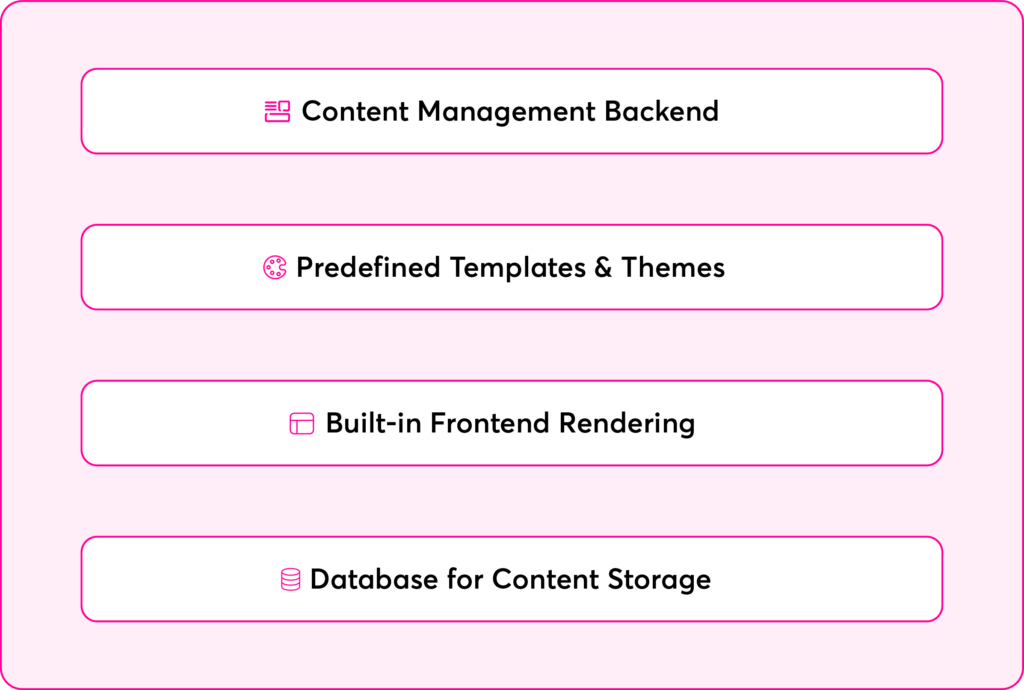
Remember when websites were simple pages of text and images? Those days are long gone. Today’s digital landscape demands content that flows seamlessly across websites, mobile apps, IoT devices, and whatever comes next. This evolution has sparked a revolution in modern content management, leading many businesses to question the benefits of headless CMS vs traditional CMS systems.
Think of your CMS as the engine room of your digital presence. Just as a modern factory needs flexible, automated systems rather than rigid assembly lines, today’s businesses need content management solutions that can adapt to changing demands and technologies.
The explosion of digital content and channels has transformed how businesses connect with their audiences. We’re no longer just publishing web pages—we’re creating experiences that span multiple platforms and devices. This shift has exposed the limitations of traditional CMS platforms and paved the way for headless architecture to emerge as a game-changing solution for modern content management.
Traditional CMS: the all-in-one package
A traditional CMS, like WordPress or Drupal, is like a pre-furnished house. Everything you need—from the backend database to the frontend templates—comes bundled together. Content creators get a familiar interface where they can write content, add images, and hit publish, all in one place.
The structure looks something like this:

While this approach has served well for years, it comes with notable limitations:
- Rigid structure: Like trying to rearrange furniture in a small room, you’re constrained by the system’s predetermined layout and design options
- Performance challenges: As your content grows, the tightly coupled nature of traditional CMS can lead to slower load times
- Limited scalability: Adding new channels or features often requires complex workarounds
- Frontend constraints: You’re typically locked into specific technologies and frameworks
Enter headless CMS: the flexible future
A headless CMS takes a different approach by separating the content management backend (the “body”) from the presentation layer (the “head”). Think of it as a content hub that can feed any number of “heads”—websites, mobile apps, digital displays, or even voice interfaces.
Popular headless CMS solutions like Contentful and Strapi offer:
- API-first architecture for flexible content delivery
- Framework-agnostic implementation
- Cloud-native scalability
- Built-in versioning and content modelling
Why the separation matters…
Imagine you’re running a restaurant. With a traditional CMS, you’re stuck with one fixed menu that everyone must use. A headless CMS is like having a central kitchen that can serve multiple restaurants, each with its own menu design and presentation style, all using the same high-quality ingredients.
Key differences that drive the switch
Understanding the fundamental differences between headless CMS vs traditional CMS helps explain why modern businesses are making the transition:
| Aspect | Traditional CMS | Headless CMS |
| Flexibility & customisation | Like a pre-built house with fixed layouts – you’re limited to built-in themes and templates. Development teams often struggle with system constraints. | Complete creative freedom – build unique experiences using any frontend technology. Teams can innovate without platform limitations. |
| Scalability & performance | Performance typically degrades as content grows. Each new piece of content or traffic spike strains the system, leading to slower load times. | Distributed content delivery and optimised API calls ensure consistent performance. Content can be cached at the edge for lightning-fast delivery. |
| Multichannel delivery | Struggles with content delivery across different channels. Often requires separate systems or complex plugins for each new platform. | Treats all channels equally through a unified content hub. Seamlessly delivers to websites, apps, IoT devices, and more through APIs. |
| Development efficiency | Forces developers to learn system-specific languages and workflows, often using outdated tools. | Enables modern development practices with preferred tools and frameworks, leading to faster development cycles. |
1. Flexibility and customisation
Modern development teams need the freedom to innovate and create unique digital experiences. Traditional CMS platforms often feel like working with one hand tied behind your back—you’re limited to the system’s built-in themes and templates. In contrast, headless CMS benefits include complete frontend flexibility, allowing developers to use any framework or technology stack they prefer. This means you can create truly unique experiences that align perfectly with your brand and user needs.
2. Scalability and performance
In traditional CMS setups, every new piece of content or spike in traffic puts additional strain on your system, potentially leading to slower load times and decreased performance. Headless CMS architectures solve this through distributed content delivery networks and optimised API calls. Your content can be cached at the edge, ensuring lightning-fast delivery regardless of user location or device type.
3. Multichannel delivery
Today’s users expect seamless experiences across all touchpoints. Traditional CMS platforms often struggle with multichannel delivery, requiring separate systems or complex plugins for each new channel. A headless CMS treats all channels equally—whether it’s a website, mobile app, digital signage, or voice interface. This unified content hub approach ensures consistency while significantly reducing content management overhead.
4. Development efficiency
Modern development teams work best with modern tools. Traditional CMS platforms often force developers to learn system-specific languages or workflows. Headless CMS benefits include the freedom to use modern development practices, continuous integration/deployment pipelines, and preferred development tools. This leads to faster development cycles and more innovative solutions, as well as categorising and responding to customer inquiries. This helps you understand the platform’s capabilities before tackling more complex projects.
When should you consider the switch?
Let’s explore specific scenarios where the benefits of headless CMS really shine:
Global operations requiring multiple languages and regional variations
Managing a global digital presence requires more than just translated content. Each region might need different layouts, features, and content structures. A headless CMS excels here by separating content from presentation, allowing teams to create region-specific experiences while maintaining a single source of truth for content.
E-commerce platforms needing seamless omnichannel experiences
Modern e-commerce isn’t just about your website anymore. Customers expect to shop through mobile apps, social media, voice assistants, and even augmented reality experiences. Headless architecture enables this omnichannel approach by delivering content through APIs that any frontend can consume.
Content-heavy platforms requiring high performance
Media companies, educational institutions, and content marketplaces often struggle with traditional CMS performance as their content libraries grow. Headless CMS benefits include optimized content delivery and caching mechanisms that maintain performance even with massive content volumes.
Organisations embracing digital transformation and innovation
Companies serious about digital transformation need flexible, future-proof content management solutions. A headless CMS provides the architectural foundation needed to experiment with new technologies and adapt to changing market demands quickly.
Looking ahead: the future of content management
The future of digital content is dynamic, personalised, and channel-agnostic. Headless CMS prepares businesses for this future by providing:
- Flexibility to adapt to new technologies
- Scalability to support growth
- Efficiency in content operations
- Future-proof architecture
While traditional CMS platforms aren’t disappearing overnight, the shift towards headless architecture represents a fundamental evolution in modern content management. It’s not just about managing content anymore—it’s about creating seamless digital experiences that can evolve with your business and your audience’s expectations.
For organisations looking to stay competitive in an increasingly digital world, the question isn’t whether to consider headless CMS vs traditional CMS, but when to make the transition. The investment in flexibility and scalability today sets the foundation for innovations we haven’t even imagined yet.
